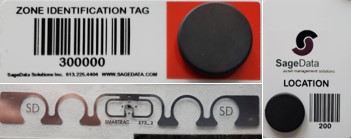Passive UHF RFID tags
SageData is based in Ottawa, Ontario, Canada
An RFID tag can be uniquely identified by a receiver which decodes a radio signal that
the
tag
transmits. Passive RFID
tags are not directly powered, but absorb energy radiated by the reader. The energy is stored
until
there is
sufficient to enable the tag to transmit a short burst of radio energy that is
encoded with the unique ID of the tag. There are currently three bands of signal most used by
passive RFID Tags,
which can be LF, HF or UHF (Ultra High
Frequency).
UHF tags are the highest frequency of the three types.
Advantages of Passive RFID tags vs Active RFID tags
Benefits of passive (compared to active) RFID tags include small size and lower
cost.
A
typical
tag is about four inches long, and inch wide, and less than a millimeter thick.
Most of the area of the tag is taken up by the antennae, and these come in an array of shapes.
The smarts
of the tag are carried on a small chip, usually at the centre of the tag, and
the
size
of
the chip is generally less than 2mm square. The antennae is usually printed on clear plastic
material.
The tag is often part of an adhesive label and can easily be attached to a container,
or any other item that needs to be tracked. But this is just the standard
tag. Passive
UHF
tags are now available in a bewildering array of configurations, from small button format,
to plastic encapsulated tags which can be six inches long and more than a quarter of an inch
thick.
Depending on type, manufacturer and quantity, as a general guide assume that passive RFID tags are going to cost $1 to $3 for HF tags, and 50c to $6 for UHF tags. This compares to prices in the range $5 to $30 each for Active RFID tags. (Prices are changing rapidly, these are rough numbers as a general guide).
Advantages of UHF RFID tags vs HF and LF RFID tags
Advantages include lower cost and greater range. HF RFID Tags require a complete circuit, which means that they must be printed on both sides of the support material, much like a two sided printed circuit board. This puts the manufacturing cost and price up. The range of an HF tag is typically from a few inches up to a foot or so. The range of a UHF tag can be up to twenty feet, depending on tag type and reader capability.
Range
A Passive UHF RFID tag can typically be read at a range up to twenty feet.
This compares well against LF and HF tags. For LF tags, range can be less than an inch. for HF
tags,
range can
be to a twelve inches.
The longer range is not always
a good thing. In systems where the tag is used as a locator, range can be deliberately reduced,
and this is often done by reducing the gain
of the reader.
Effect of surroundings and orientation
Surroundings
Perform this test. Take a naked UHF tag. Check the range. Place it on a metal filing cabinet. Try to read it. In most cases, it can't be read, even at three inches. Now lift the tag off the metal surface by a few millimeters, and the tag can be read quite happily. There are specialized tags available today which can be fixed to a metal surface without degradation of the read range. In some cases range can even be enhanced.
Orientation
All Passive RFID tags harvest their energy from ambient radio signals, usually
transmitted
by the reading device. (It goes transmit, stop, listen
). So the degree of linkage
between the antennae on the reader and the antennae on the tag is critical. This can be enhanced
by
ensuring that they are aligned correctly. So readers use one of two types of antennae, with
circular or linear polarization. The trade off is between range and orientation.
With circular polarization, alignment is not critical, but range is reduced.
A linear antennae in the reader will give greater range, but the receiver and tag antennae must
be
aligned. Twist the reader through ninety degrees, and the range drops dramatically.
Life
There is no practical limit to life of an passive RFID tag, in contrast to the life of an active tag, which is limited by the battery.
Temperature Range
Passive UHF Tags work well at normal
temperatures. Performance can be degraded
at
more
than
twenty degrees below zero, but performance returns as soon as the tag is warmed to
temperatures in the normal operating range.
Applications
Because Passive UHF Tags are small in size and low in cost they are ideal for a number
of
tracking and material management applications. They can be used to identify and track
physical assets, to track files and documents, to track chemicals, and to provide a Geiger
counter
style of function suitable for locating lost items.

If you found this useful, you might also want to review:
- active RFID tags
- RFID read range
- RFID limitations
- RFID myths
QAOK5360
